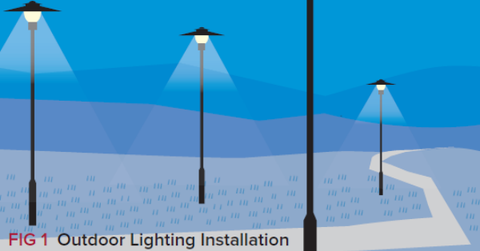This article considers the requirements applicable where the protective measure of Automatic Disconnection of Supply is used for outdoor installations.

Outdoor lighting installations, such as those listed below, should satisfy the specific requirements of Section 714 of BS 7671. This article considers the requirements applicable where, as is usually the case, the protective measure of Automatic Disconnection of Supply is used for outdoor installations, such as:
- lighting installations for roads, parks, car parks, gardens, places open to the public, sporting areas, illumination of monuments and floodlighting
- telephone kiosks, bus shelters, advertising panels and town plans, and road signs.
Access doors and access into luminaires
A door in street furniture, such as a lighting column, must not be used for the purposes of a barrier or enclosure for basic protection against electric shock (Regulation 714.411.201 refers). This means that when the door is open (or removed), the risk of contact with live parts as shown in Fig 2 must be prevented either by insulation or by a barrier or enclosure.
Any door at less than 2.5 m above ground level giving access to equipment must be locked with a key or require the use of a tool to open it (Regulation 714.411.2.201 refers). Similarly, access to the light source of a luminaire less than 2.8 m above ground level must be possible only by removing a barrier or enclosure that requires the use of a tool.
Enclosures
Access to the interior of an accessible enclosure containing live parts must be by the use of a tool or key (Regulation 714.411.2.201 refers). An exception is allowed where only skilled or instructed persons have access to the enclosure but, even then, one of the other means of preventing access to live parts required by Regulation 416.2.4 must be provided (interlocked isolation device or intermediate barrier).
Protective bonding
There is a relaxation from the general requirement of Regulation 411.3.1.2 to main bond extraneous-conductive-parts, in that metallic structures such as fences (Fig 3) that are in the proximity of an outdoor lighting installation are not required to be connected to the main earthing terminal (Regulation 714.411.3.1.2 refers).
Additional protection by RCDs
Regulation 714.411.3.3 requires additional protection by an RCD (with residual operating current, IΔn, not exceeding 30 mA and an operating time not exceeding 40 ms at 5 IΔn) to be provided for lighting in telephone kiosks, bus shelters, town plans and similar locations.
Disconnection times
Regulation 714.411.202 permits a disconnection time of up to 5 seconds for a distribution circuit supplying fixed equipment (such as lighting columns or distribution boards) used in highway power supplies in a TN or TT system. Although, in the case of a TT system, this is a relaxation to the general requirement of Regulation 411.3.2.4 for a disconnection time not exceeding 1 s. It should be appreciated that the relaxation applies only for highway locations (as defined in Part 2 of BS 7671).
Size of earthing conductor
Where a PME supply is provided for street electrical furniture (such as a lighting column or highway distribution board), in the event of a discontinuity occurring in the supplier’s neutral conductor, the earthing and bonding conductor of the street electrical fixture may have to carry diverted neutral current returning to the distribution transformer via the metalwork of the street electrical fixture and the general mass of Earth.
Consequently, Regulation 714.411.203 requires the earthing and bonding conductor to have a minimum cross-section of 6 mm² (copper) for a supply neutral conductor of up to 10 mm² (copper equivalent). Where the supplier’s neutral exceeds 10 mm² the bonding conductor should be sized in accordance with Table 54.8 of BS 7671.
External influences
While recommended and minimum classes for external influences are given in Regulation 714.512.2.1, electrical equipment forming part of the installation should, by construction and/or the manner of its installation, have a degree of protection of at least IP33 (Regulation 714.512.2.105 refers).
Devices for isolation and switching
Where equipment is connected to a TN system and the isolation and switching is carried out by instructed persons only, and provided suitable precautions are taken to prevent any equipment from being inadvertently or unintentionally energised, Regulation 714.537.2.1.201 permits a fuse carrier located within the equipment to be used for the purposes of isolation and switching the supply on load. However, where the equipment can only be isolated by the electricity distributor’s cut-out, the distributor’s permission must be obtained prior to using the cut-out fuse for this purpose.
Inspection and testing
Electrical supplies to street furniture should be regularly inspected and tested in accordance with the general requirements of Part 6 of BS 7671. Guidance on completing certificates and condition reports is provided in the NICEIC and ELECSA publication: Inspection, Testing and Certification.
Where there is a programmed inspection and testing procedure in place, the warning notices that are required to display the dates for periodic inspection and testing and RCD testing as required by Regulations 514.12.1 and 514.12.2 may be omitted (Regulation 714.514.12.201 refers).
For other guidance and publications please see the NICEIC website. For information about the NICEIC Approved Contractor or Domestic Installers schemes, visit www.niceic.com
